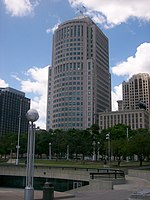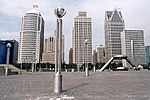One Griswold Street
1930 establishments in MichiganDowntown DetroitHistoric district contributing properties in MichiganLimestone buildings in the United StatesNRHP infobox with nocat ... and 8 more
Neoclassical architecture in MichiganOffice buildings completed in 1930Office buildings in DetroitProperties of religious function on the National Register of Historic Places in MichiganReligious buildings and structures in DetroitScientology propertiesUse American English from May 2022Use mdy dates from May 2022

One Griswold Street (formerly also known as the Standard Savings Building and the Raymond James Building) is a high-rise building in the Financial District of Detroit, Michigan, United States. The building sits at the intersection of Griswold Street and West Jefferson Avenue, on the same city block occupied by 150 West Jefferson. Since 2007, the building has been owned by the Church of Scientology, which operates the building as the Church of Scientology Detroit. Between 2017 and 2018, the building underwent an extensive renovation that restored much of its interior appearance, including a grand staircase and mezzanine for the first and second floors.
Excerpt from the Wikipedia article One Griswold Street (License: CC BY-SA 3.0, Authors, Images).One Griswold Street
Griswold Street, Detroit
Geographical coordinates (GPS) Address Nearby Places Show on map
Geographical coordinates (GPS)
| Latitude | Longitude |
|---|---|
| N 42.328472222222 ° | E -83.045972222222 ° |
Address
Church of Scientology
Griswold Street 1
48226 Detroit
Michigan, United States
Open on Google Maps










